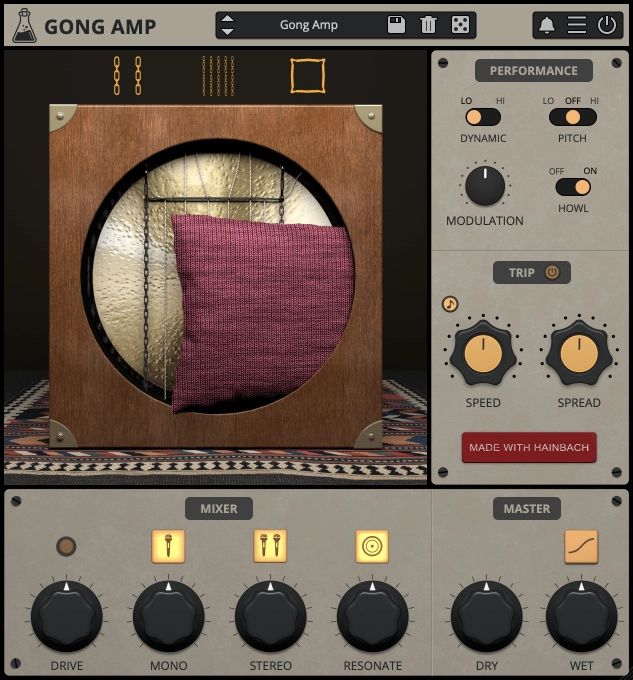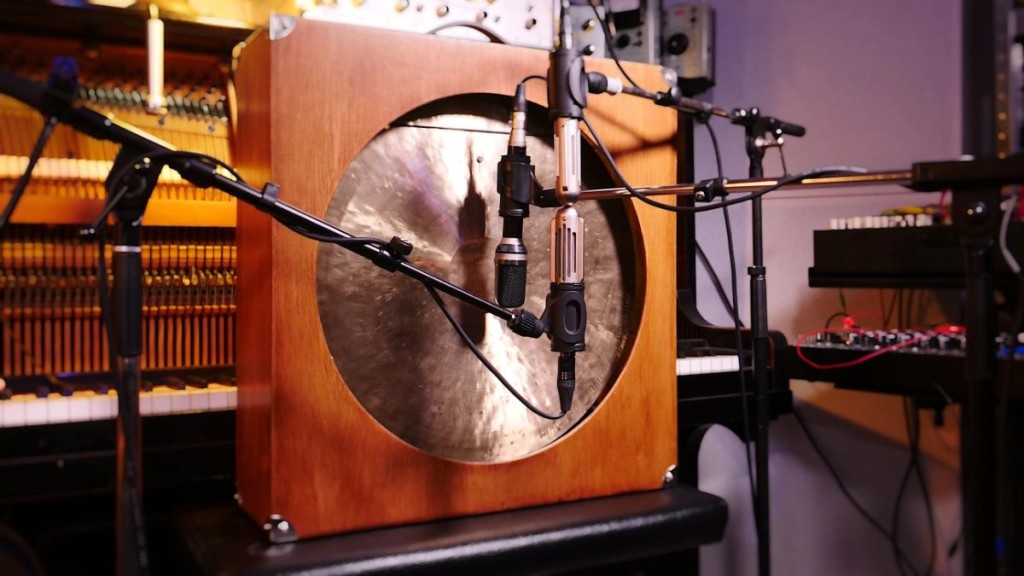The plug-in recalls the 1930s experiments of Maurice Martenot – and it comes with buttons to add chains and a pillow.
Gong Amp has a history that starts with the avant-garde composer’s Resonateurs Métalliques, and as such harkens back to a time when sound synthesis was wide open and acoustic techniques mixed with optical, kinetic, and other mechanisms, not just voltage. Boutique French maker Eowave built their own design starting in 2011 from the concept – and by the way, it’s on its way back soon, meaning the plug-in just became a nice advertisement for the hardware re-release:
Metallik Resonator Speaker [Eowave]
The concept is simple – you amplify the sound through a metal tam, so instead of the neutral sound of a conventional cone, you get all the ringing qualities of the metal. Because that brings the sound from the electrical into the physical world, you can mess with the metal just as a percussionist would.

Gong Amp does just that, with the ability to add chains of two alternate weights for sympathetic rattles, and a pillow for dampening.
Hainbach picked up the Eowave amplifier and showed it off – evidently helping inspire the plug-ins development:
And so, following up on their Soviet tape machine plug-in collaboration Wires from last year, AudioThing and Hainbach again partner to develop a plug-in.
In comparison to Wires, Gong Amp is pretty simple – it’s really mainly about the emulation of the gong amp itself. Before you say “couldn’t I just use convolution and a cymbal sample,” the effect is convincing and organic in a way that convolution alone can’t reproduce. The first time I switched it on, I just about did a double-take – it’s that realistic. The developers say they’ve used convolution in combination with physical modeling and feedback systems in a “complex mixture.”

There are some parameters to mess with. Dynamic adjusts the gain setting to “lo” or “hi”; there’s no in-between setting, but in combination with the Mixer section and Drive and Resonate controls, plus dedicated Dry and Wet knobs, there’s plenty of control over gain and resolution. That’s really the main point of this thing, in that you can get subtle ringing or aggressive rattles and distortion in lots of different combinations depending on how you adjust gain structure. (Modulation also runs both pre- and post-gong.)
HOWL is probably the best setting – it lets you trigger an overloaded gong, which produces beautifully organic, distorted results. PITCH runs in extremes in a register above or below the gong, and it’s reminiscent of what you get with AudioThing’s Texture plug-in.
You also get options for mono and stereo miking – stereo sounds nice enough that I tended to just leave it on. Hainbach also evidently created the Resonate parameter himself; it feeds reverb into reverb.
Resonate is simply genius, and I wound up using it a lot even before really asking what it does. Hainbach explains:
Resonate is a weird effect I made by stacking reverb on harmonizer on reverb on a set of bandpass filters. The convolution of that resulted in a beautiful spectral smear and then we added more effects on it.
The goal was to create an impossible resonance with it – one that feels like it’s not a place at all, but like messing with time.
There’s also a Trip Mode, which automates modulation of mono, stereo, and resonate mix, effectively crossfading between them. You can run that quickly enough to get rotary-style effects and adjust the width between shift with the Spread parameter. The resulting sound is pretty psychedelic at higher rates, so this is aptly named.

The goal was to create an impossible resonance with it – one that feels like it’s not a place at all, but like messing with time.
Hainbach
If I had any criticism of Gong Amp, it’s that it is definitely a bit of a one-trick pony – which would be true of the original, as well. You just get a lot of the sound of the particular cymbal. There are other ways of using cymbals of varying size with amplified sound and pick-ups in various combination; the disadvantage of a single fixed cymbal is, you have one ringing characteristic for everything.
In practice, though, that challenge forces you to feed different kinds of source material into the effect, which is sort of the point of this approach. And because AudioThing and Hainbach did such an exceptional job of modeling, you get tons of variety by adjusting gain. The chains are simply beautiful in different combinations, and it’s ultimately the pillow that makes the plug-in something you’d use over the long haul. After you play around with long ringing resonance for a while, adding the pillow means you can start to throw this on anything. It’s a beautiful way of getting unexpected results in tracks.
But sure, I wouldn’t mind a couple of alternate cymbals/tams/gongs. Gong Amp Pro?
(I’m also suspicious that given the complexity of their model here, if they did provide unlimited parameters that let you freely adjust input gain and cymbal size and even unrealistic controls over model and dampening settings, the whole thing would fall apart and feedback. It’d be both unrealistic and unruly. But hey, AudioThing, if you ever do want to provide an experimental mode on this thing, I’d be up for it. The “DESTROY YOUR EARS AND STUDIO MONITORS CDM EDITION”?)
I was going to include some sound examples here, and might still later tonight, but they’ve got plenty of good ones up. I tried it last night for a live performance, and it was beautiful to work with live – especially as you begin to imagine the physical speakers are there.
It’s a Hainbach joint, so of course there’s a video coming – live here from 18:00 Berlin time/CET:
And the plug-in is on sale now for €39, after which it increases to 59. macOS, Windows, M1 support (Universal 2 Binary), VST2, VST3, AU, AAX. Resizable window.
And yeah, ideal activation – no iLok, no Internet connection required, three computers for one license.
All the AudioThing stuff is on sale now, too, so if this isn’t your speed, check out the other stuff.
www.audiothing.net/effects/gong-amp/